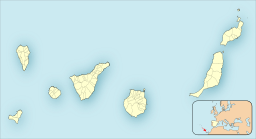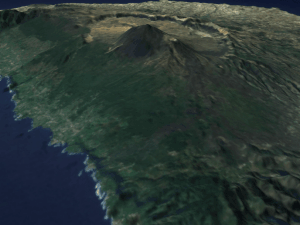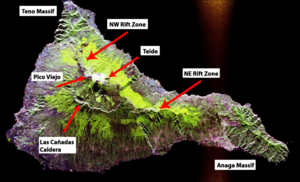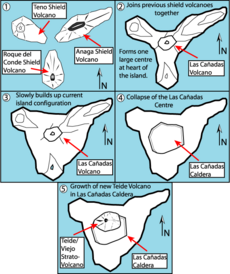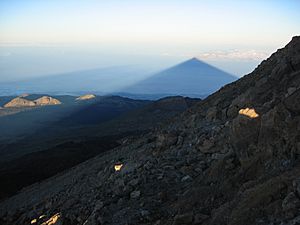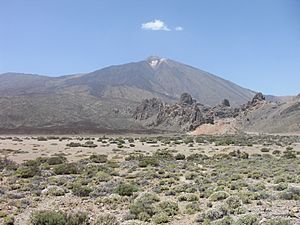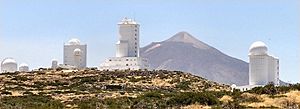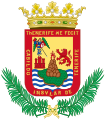Teide facts for kids
Quick facts for kids Teide |
|
|---|---|
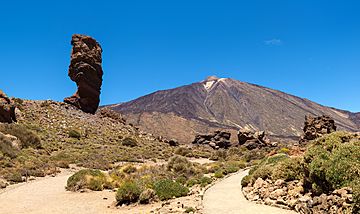
Teide volcano and Roque Cinchado (left).
|
|
| Highest point | |
| Elevation | 3,715 m (12,188 ft) |
| Prominence | 3,715 m (12,188 ft) Ranked 40th |
| Listing | Country high point Ultra |
| Geography | |
| Location | Tenerife, Canary Islands, Spain |
| Geology | |
| Mountain type | Stratovolcano atop basalt shield volcano |
| Last eruption | 18 November 1909 |
| Climbing | |
| First ascent | 1582 |
| Easiest route | Scramble |
Teide, also known as Mount Teide, is a huge volcano on the island of Tenerife. Tenerife is one of the Canary Islands in Spain. Its top is the highest point in Spain. It is also the highest point above sea level in all the Atlantic islands.
If you measure Teide from the ocean floor, it is about 7,500 meters (24,600 feet) tall. This makes it the third-highest volcano in the world. UNESCO and NASA even call it Earth's third-tallest volcanic structure. Teide is an active volcano. Its last eruption happened in 1909.
The United Nations calls Teide a Decade Volcano. This is because it has had powerful eruptions in the past. It is also very close to many towns. Teide, Pico Viejo, and Montaña Blanca together form the main volcanic area of Tenerife.
The volcano and its surroundings are part of Teide National Park. This park covers a huge area of 18,900 hectares (46,700 acres). UNESCO named it a World Heritage Site in 2007. Teide is Spain's most visited natural wonder. It is also the most visited national park in Spain and Europe. By 2016, over 4 million people visited it each year. The Teide Observatory, a big international astronomical observatory, is also on the mountain's slopes.
Contents
Teide's Name and Old Stories
Before Spain took over Tenerife in 1496, the native people were called the Guanches. They believed a powerful spirit lived inside the volcano. This spirit brought light, power, and the sun. Today, its Spanish name is El Pico del Teide, meaning "Peak of Teide."
Teide was a sacred mountain for the Guanches. They thought it was a mythological place, much like Mount Olympus was to the ancient Greeks. When Teide erupted, the Guanches would light bonfires. They did this to scare away Guayota, an evil spirit. Guayota was often shown as a black dog with other demons.
The Guanches also believed Teide held up the sky. Many hidden spots in the mountains have old stone tools and pottery. People think these were offerings to fight off evil spirits. The Guanches thought the mountain was home to evil forces and the most evil spirit, Guayota.
Guayota is similar to other gods who live in volcanoes. For example, the goddess Pele in Hawaiian mythology lives in the Kīlauea volcano. She is believed to cause eruptions. The ancient Greeks and Romans also thought that Vulcano and Mount Etna were the workshops of the fire god Hephaestus (or Vulcan in Latin).
In 1492, Christopher Columbus sailed past Tenerife. His crew said they saw flames coming from the island's highest mountain, Teide.
How Teide Was Formed
Teide and Pico Viejo are the newest volcanoes on Tenerife. Tenerife is the largest and highest island in the Canary Islands. The island and Teide volcano formed over five main steps.
First, Tenerife was built by large shield volcanoes. These volcanoes grew quickly a long time ago. Their remains can still be seen in three old mountain areas: Anaga, Teno, and Roque del Conde.
After this, there was a quiet period for millions of years. Then, volcanic activity started again in two main places. One was the central volcano of Las Cañadas. This volcano grew very large, possibly 40 kilometers (25 miles) wide and 4,500 meters (14,800 feet) high.
Around 160,000 to 220,000 years ago, the top of the Las Cañadas volcano collapsed. This created a huge bowl-shaped area called the Las Cañadas caldera. Later, other volcanoes formed inside this caldera and also collapsed. Teide is sometimes called the "Las Cañadas IV volcano."
Scientists have two ideas about how this big caldera formed. One idea is that the volcano collapsed downwards. This happened when magma chambers under the volcano emptied after huge eruptions. The second idea is that the caldera formed from large landslides. These landslides were similar to those seen in Hawaii.
Finally, from about 160,000 years ago until today, the Teide and Pico Viejo volcanoes grew inside the Las Cañadas caldera.
Past Eruptions of Teide
Teide's last eruption was in 1909. It came from a vent called El Chinyero. Other eruptions on the island happened in different areas. For example, in 1706, an eruption destroyed the town of Garachico.
The Teide and Pico Viejo volcanoes themselves had an eruption in 1798. This happened from the Narices del Teide, or "Teide's Nostrils." Lava from these volcanoes partly fills the Las Cañadas caldera. The last big explosive eruption from the main volcanic center was about 2,000 years ago.
Christopher Columbus reported seeing "a great fire" in 1492. He saw it as he sailed past Tenerife. People thought he saw an eruption. However, studies show that no eruption happened in that specific valley then. But an eruption did happen from another vent nearby.
The very last eruption from Teide's summit was around 850 AD. This eruption created the "Black Lavas" that cover much of the volcano's sides.
About 150,000 years ago, a much bigger eruption happened. It was a very powerful explosion. This created the large Las Cañadas caldera. This caldera is about 16 kilometers (10 miles) from east to west. It is also 9 kilometers (5.6 miles) from north to south. Teide's summit and Pico Viejo are both inside this caldera. They formed from eruptions that happened after this ancient explosion.
What About Future Eruptions?
Scientists think future eruptions might include fast-moving flows of hot gas and rock. These are called pyroclastic flows. They are similar to those from volcanoes like Mount Pelée or Vesuvius. In 2003, there was more earthquake activity at Teide. A crack also opened on its side. No eruption happened, but magma might have moved inside the volcano. This can sometimes mean an eruption is coming, but not always.
Teide's structure is also thought to be a bit unstable. Its northern side has a noticeable bulge. The top of the volcano has small active vents. These vents release gases like sulfur dioxide.
A study in 2006 said that eruptions have been rare over the last 30,000 years. Most of them were low-hazard lava flows. This suggests a hopeful outlook for the people of Tenerife. However, another study in 2009 said Teide might erupt violently in the future. It said Teide's structure is like that of Vesuvius and Etna. So, how much risk Teide poses is still something scientists discuss.
Famous Climbs of Teide
In 1626, Sir Edmund Scory wrote about Teide. He described good paths to the top. He also noted how the height affected climbers. This shows people were climbing Teide before the 17th century. In 1715, J. Edens and his group also climbed it. They shared their findings in a science journal.
After the Age of Enlightenment, many trips to Africa and the Pacific stopped at Teide. It was a rewarding place to visit. In 1792, Lord George Macartney and his team almost had a disaster. A big snowstorm hit them. They could not reach the peak of Teide.
The German scientist Alexander von Humboldt visited Tenerife in 1799. He climbed Teide with his friend Aimé Bonpland and local guides.
In 1894, the German adventurer Hans Heinrich Joseph Meyer visited Teide. He wanted to study the ice on the volcano. He said Teide and Kilimanjaro were like "two kings." One rises from the ocean, and the other from the desert.
More recently, in 2017, Gema Hassen-Bey made history. She became the first Paralympic athlete in a wheelchair to reach 3,000 meters (9,800 feet) using only her arms. She hoped to reach the very top of Teide. But bad weather stopped her from reaching the summit.
Plants and Animals of Teide
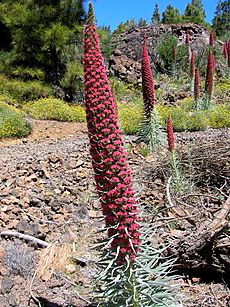
The lava flows on Teide's sides create a thin, rich soil. This soil helps many different plants grow. There are 168 types of plants. Thirty-three of these plants are found only on Tenerife.
Forests of Canary Island Pine trees grow from 1,000 to 2,100 meters (3,300 to 6,900 feet) high. These forests cover the middle slopes of the volcano. Inside the Las Cañadas caldera and at higher places, you can find special plants. These plants only grow in Teide National Park.
Some unique plants include:
- Teide white broom: It has white flowers.
- Descurainia bourgaeana: A yellow-flowered shrub.
- Canary Island wallflower: It has violet flowers.
- Teide bugloss (Echium wildpretii): Its red flowers form a pyramid up to 3 meters (10 feet) tall.
The Teide daisy grows close to 3,600 meters (11,800 feet) high. The Teide violet can even be found right at the summit. This makes it the highest flowering plant in Spain.
These plants have special ways to live in the volcano's harsh environment. They can handle high altitude, strong sunlight, big temperature changes, and little water. They often grow in round shapes. They might have fuzzy or waxy leaves. They also produce many flowers. Most plants flower in late spring or early summer, in May and June.
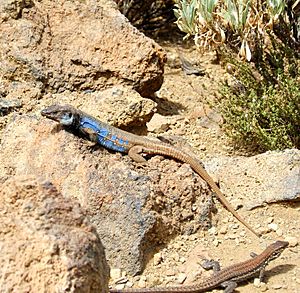
Teide National Park has many kinds of invertebrates. These are animals without backbones. Over 40% of them are found only here. Seventy species are found only in this park. These include spiders, beetles, and different kinds of flies and wasps.
However, Teide National Park has only a few types of vertebrates. These are animals with backbones. Ten bird species nest here. These include the Tenerife blue chaffinch, Berthelot's pipit, and the Atlantic canary. A type of kestrel also lives here.
Three types of reptiles are found only in the park:
- The Canary Island lizard (Gallotia galloti galloti).
- The Canary Island wall gecko (Tarentola delalandii).
- The Canary Island skink (Chalcides viridanus viridanus).
The only mammals naturally found in the park are bats. Leisler's bat is the most common. Other mammals like mouflon (a type of wild sheep), rabbits, mice, rats, cats, and hedgehogs have all been brought to the park by humans.
Teide's Amazing Shadow
Teide casts the world's largest shadow over the sea. This shadow stretches more than 40 kilometers (25 miles) from the mountain's top. At dawn, it reaches as far as the island of La Gomera. At sunset, it reaches the island of Gran Canaria. The shadow looks like a perfect triangle. This is true even though Teide's shape is not a perfect triangle. This happens because of how we see things from far away. Many visitors climb to the top of the volcano at sunset to see this amazing sight.
Teide for Science
Teide National Park is a great place to study volcanoes. It is also useful for studies about Mars. This is because Teide's environment and rock formations are similar to those on Mars. In 2010, scientists tested a special instrument called a Raman instrument at Teide. They plan to use this instrument on the ESA-NASA ExoMars mission. In 2011, a team from the UK visited the park. They tested ways to look for life on Mars. They also searched for good places to test new robots.
How to Visit Teide
The volcano and its surroundings are part of the Teide National Park. A public road crosses the park from northeast to southwest. Buses run once a day from Puerto de la Cruz and Playa de las Americas to Teide. The park has a hotel and a small church.
A cable car takes visitors almost to the summit. It starts at 2,356 meters (7,730 feet) and goes up to 3,555 meters (11,663 feet). It carries up to 38 people and takes eight minutes. To climb the last 200 meters (660 feet) to the very top, you need a free permit. Only 200 people are allowed each day. Several paths also lead hikers to the cable car station and then to the summit.
Because Teide is so high, the air is much thinner than at sea level. This can make people feel light-headed or dizzy. Some might even get altitude sickness. In serious cases, people can lose consciousness. The only way to feel better is to go back to lower altitudes and let your body get used to it.
Teide Astronomical Observatory
An astronomical observatory is located on the mountain's slopes. It uses the good weather and high altitude. Being high up means it is above most clouds. This helps scientists get clear views of space. The Teide Observatory is run by the Instituto de Astrofísica de Canarias. It has telescopes that look at the sun, radio waves, and microwaves. It also has traditional telescopes for looking at the night sky.
Teide as a Symbol
Teide is the most important symbol of Tenerife. It is also the most famous natural landmark of the Canary Islands. An image of Teide, with flames coming out, is in the middle of Tenerife's coat of arms. Above the volcano is St. Michael, who is the patron saint of Tenerife. The flag colors of the island are dark blue for the sea. The white stands for the snow-covered peaks of Mount Teide in winter. The logo of the Cabildo de Tenerife (the island's government) also shows Teide erupting.
Teide has been shown in many ways throughout history. It appears in old drawings by European explorers. It is on traditional Canary Island crafts. It was even on the back of old 1000-peseta banknotes. It is also seen in paintings and on postcards.
In the Canary Islands, especially on Tenerife, Teide has deep cultural meaning. It is often called Padre Teide, which means "Father Teide."
-
An old 1000-peseta banknote.
Teide and the Moon
Mons Pico is a mountain on the Moon. It is part of the Montes Teneriffe mountain range. This lunar mountain was named by Johann Hieronymus Schröter. He named it after the Pico von Teneriffe, an old name for Teide.
There is also a brown dwarf star called Teide 1. It is found in the Pleiades star cluster.
See also
 In Spanish: Teide para niños
In Spanish: Teide para niños


